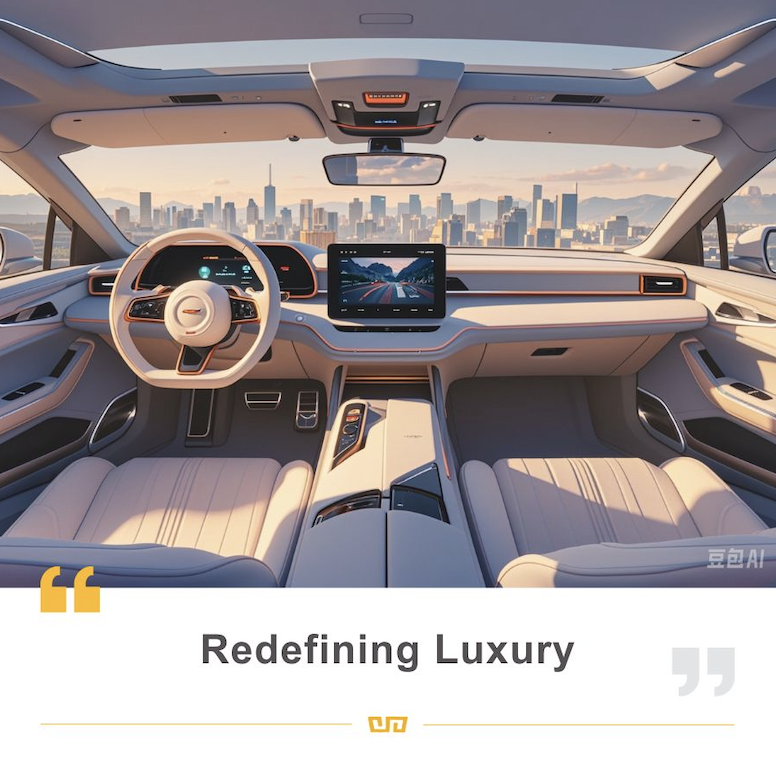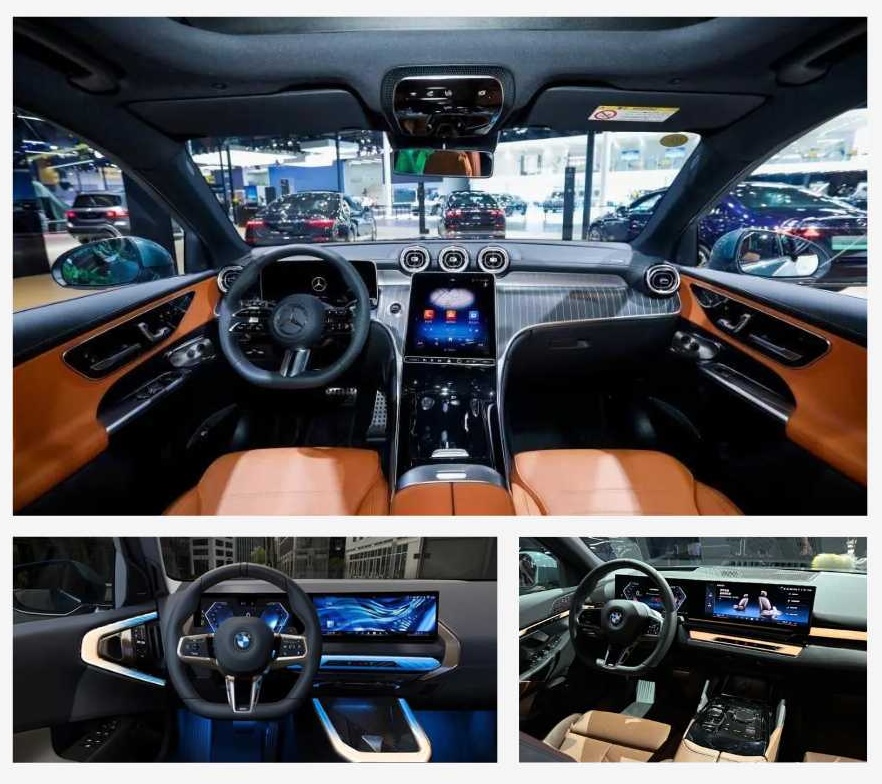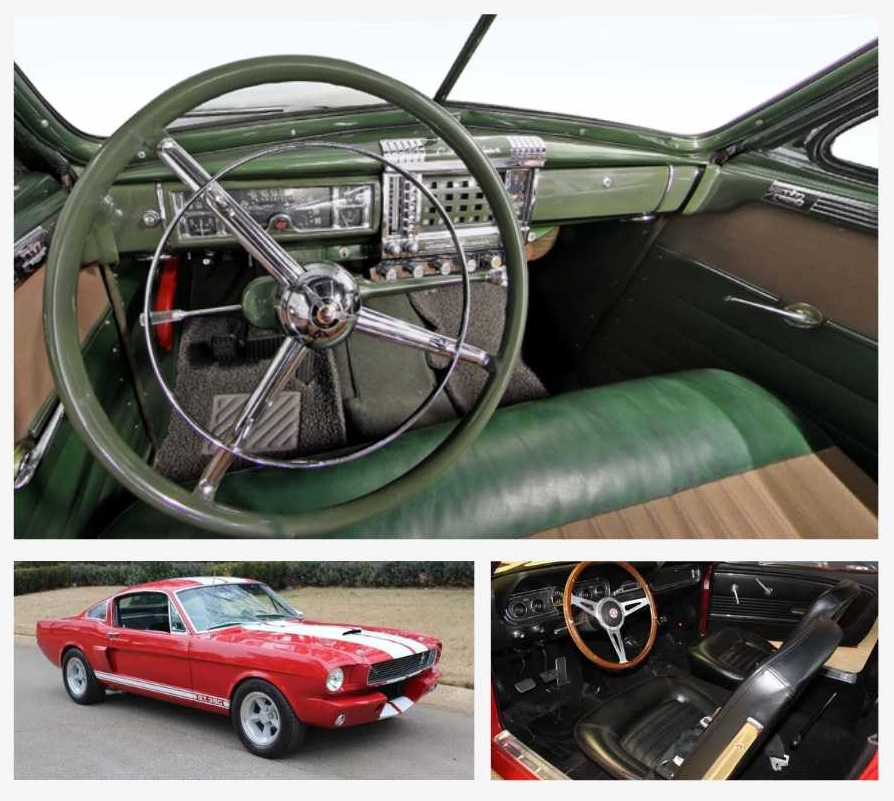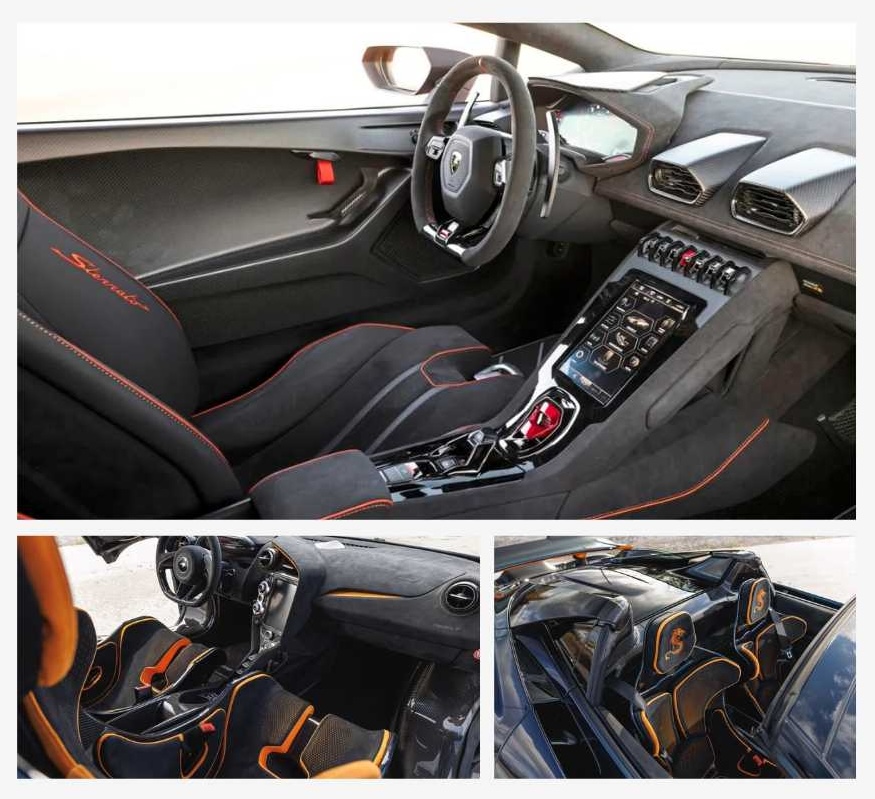What is Microsuede? New Winner Behind a Soft Power Warfare of Auto Enterprises | JD Insights
2024-09-25

Abstract: Redefining Luxury
Shared by.
Managing Director, Li Jianli lijl@jiudingcapital.com
Investment Director, Wang Yong wangyong@jdcapital.com
If you can buy a car with 10000 yuan more budget, what would you like to add to the configurations?
This is both a simple and complex question for every car user. A more powerful power system, a more advanced intelligent driving feature, or a more luxurious interior?
Today, the options may be richer than you think.
At the recent 2024 Chengdu Auto Show, a subtle change that is taking place is that models of traditional luxury brands such as BBA are beginning to move closer to domestic new forces brands on interior design.

(Interior of some new models of luxury brands at 2024 Chengdu Auto Show)
In the past, the biggest difference between luxury brand models and ordinary models is the creation of luxury. This kind of "luxurious feeling" mainly comes from the use of a large number of materials such as leather, chromeplate and wood grain.
But now, a revolution of design philosophy is undergoing.
Taking NIO, XPENG and Li Auto as examples, their models are equipped with refrigerator, color TV, big sofa and on-board AI system to build a sense of technology for users. At the same time, these brands used more microsuede as interior wrapping material to create a new sense of luxury in vision, feeling and comfort.
In essence, the willingness of users to pay determined the cost and sales of cars, which is the cornerstone of the input-output ratio and the focus of competition of auto enterprises. When the competition between exterior and hardware gradually homogenizes, the interior becomes an important factor in determining the "soft power" of the car.
Exterior is important, but interior is becoming a new battlefield for automobile products.
Through our observation, some interior materials that were once only used in a few high-end luxury cars are ushering in new opportunities behind these subtle changes.
For example, microsuede once used by Lamborghini, McLaren, BMW 7 Series and other luxury models is being used by more and more auto enterprises to redefine the luxury standard of interior because of its unique texture, comfortable tactility and lower cost than natural leather.
Microsuede:
A kind of microfiber leather (third generation synthetic leather) material made by microfiber through special process, which possesses characteristics such as soft tactility, fine suede effect, excellent abrasive resistance and pro-environment. The appearance and sense of touch is similar to natural suede, but it is more economic and is easier to maintain.
In this article, we will discuss about microsuede along with the changes in automobile interior materials, and try to discuss:
● Why microsuede become the new favorite of automobile interior material in the era of new energy?
● How to seize the opportunity to establish barriers for domestic microsuede brands under a changing market stirred by new forces?
● What opportunity can we see from the perspective of investment?
Ⅰ. A hundred year of automobile interior history: From model evolution to material innovation
In 1886, the world's first car was born in Mannheim, Germany, marking a new journey for human trip mode. At that time, the car was installed on three wheels with an internal combustion engine and a sofa, which could only meet the normal start and stop functions, not to mention any interior and design.
Until the 1920s, after the appearance of fully closed rear compartment models, the era of car interior was gradually opened. By the 1930s, car interior design and color began to be considered with overall feelings, and manufacturers began to wrap metal parts such as door panels with some comfortable materials.
Since the 1960s, car interior has reached its peak. The functional divisions on the panel tend to be complete, parts such as shift rods began to be decorated with cover and seats began to be used with wood grain, leather and other wrapping materials. Represented by the American style of the time, the interior design of the vehicle is extremely luxurious, a wide variety of designs and materials can be found.

(Some classic American models and interiors from the 1960s)
With the continuous iteration of car interior design, the materials used in the interior are also constantly changing.
Usually, interior materials refer to the surface covering accessories applied to automobile interior components such as dash board, door inner panels, ceiling, column panels, seats, etc., which include fabrics, natural leather, artificial leather, etc.
Among them, fabric is one of the most common interior materials, such as polyester fiber, nylon fiber, cotton fiber and so on. Fabrics are soft, breathable and comfortable. Taking nylon fiber as an example, since the 1970s, nylon fiber has been applied to automobile interiors on a large scale with different woven structures and color effects.
As a high-end interior material, natural leather touches comfortable. Natural leather is usually made by animal leather after processing and painting, such as cow leather, sheep leather and so on. In fact, natural leather was used in car interiors much earlier than fabric.
The use of natural leather in the car, especially calfskin decoration, is recognized worldwide as a sign of luxury and nobility. But natural leather is always expensive and faces environmental challenges. With the progress of the times and the continuous improvement of technical capabilities, the degree of simulation and various technical indicators of artificial leather are constantly improving and becoming more and more popular.
Artificial leather is a kind of synthetic material based on the simulation of natural leather, which is similar to the appearance and texture of natural leather. Artificial leathers mainly including PVC leather, PU leather, microfiber leather and other types, respectively known as the first-generation synthetic leather, the second-generation synthetic leather and the third-generation synthetic leather.
Starting in the 1950s, PVC coated fabric has been widely used in automobile interiors. Since this material can be processed into a variety of different colors and can be molded on the surface to achieve different texture effects, it was once a kind of popular composite material.
However, with the improvement of living standards, consumers have put forward higher requirements for comfort. Due to the poor performance of air permeability of PVC coated seat, which made people feel hot and sticky in sweltering summer, it has gradually been replaced.
Different from PVC, microfiber leather, as the third-generation synthetic leather, is similar to natural leather in appearance, mechanical strength, elasticity, stability against chemical substances, and has better thickness uniformity, mold resistance, material utilization, etc.
From the processing terminal point of view, microfiber leather can be divided into suede microfiber and veneer microfiber. Among them, the veneer microfiber refers to the synthetic leather with lychee grain and other grain surface. Suede microfiber has no pattern and it touches like natural leather, the surface is similar to natural suede and it is smooth and wear-resistant, so it is also called microsuede.
Previously, microsuede was mainly used for racing cars and luxury brand models.
Taking the mainstream microsuede brand Alcantara® on the market as an example, it is lighter than natural leather and has a high coefficient of friction, so it rarely skids during aggressive driving, which made it suitable for packaging the steering wheel, sports seats and other areas that have more contact with the driver. It is difficult to be abrased unless man-made destruction, and the anti-fouling ability of it is also strong.
As a result, BMW 7 Series, Tesla Model S, and even Lamborghini and McLaren advertise Alcantara®.
 (Alcantara interiors in some luxury car models)
(Alcantara interiors in some luxury car models)
As an interior material, Alcantara was first born in a Japanese company.
In 1970, Dr. Mitsuki Okamoto of global materials giant Toray Industries in Japan invented Alcantara material, which has a soft texture and elegant appearance similar to natural suede, and soon became popular in the automobile, fashion and aviation sectors. In 1972, Toray and the Italian energy company ENI formed a joint venture company ANTOR for the commercial production of Alcantara materials, which is also the predecessor of Italian company Alcantara S.p.A.
In the 1980s, after cooperation with Fiat, Audi, Lancia and other car companies, Alcantara materials began to be widely used in the automobile field. In 1995, after several shareholding changes, Alcantara S.p.A. eventually became a joint venture with Japan's Toray holding 70% and Mitsui holding 30% of its shares.
Today, in addition to Alcantara®, the world's major high-end microsuede brands include Ultrasuede, which is also owned by Toray, and Dinamica that owned by another Japanese company called Asahi Kasei.
At the application level, microsuede has been widely used in seats, headrests, ceilings, columns, door panels, dash board, sunshades, steering wheels and other areas in RMB million-level luxury models.
At the same time, more and more auto enterprises have also begun to use microsuede in seats and other areas of their high-end models to enhance the sense of luxury. Such as Volkswagen's Tiguan, Tcross and ID series, Buick's Encore, Veraon, Excelle, Lacrosse, Regal and so on.
Ⅱ. OEM redefines product,microsuede redefines user experience
The evolution of interior materials is the result of the car as a modern industrial product being constantly redefined by the market.
In the era of fuel vehicles, most auto enterprises focused on engine performance, space, brand and other levels to fight it out. Today, the market consensus in the age of the electric car. Car is no longer just a means of transportation, but a third living space or a mobile home.
As a means of transportation, people care more about the car's endurance mileage, control, performance and so on. But for the "mobile home", people will inevitably care more about comfort and experience, such as the vision, touch, and even smell in the car.
In the view of JD Capital, the premise for consumers to make car purchase decisions is the basic performance and quality of the vehicle, such as vehicle power system, safety performance, control stability, etc. But on this basis, car manufacturers have to continue to increase in details and materials to win on sales nowadays.
For example, more and more car companies are offering configurations that are previously seen only in high-end models as standard configurations, which include air suspension, CDC, and so on.
At the same time, the interior materials of the vehicle also began to be upgraded. In the past, the interior of the car in the price range of RMB 200000 to 300000 was mostly made of ordinary leather. But today, in order to meet market's pursuit of high-end, more and more models have begun to use natural leather or suede. After all, it is more direct to bring user experience with comfort and luxury through visual and touching enhancement.
This strategy not only enhances the overall sense of value of the vehicle, but also meets consumers' expectations for high-end configurations. "To enjoy the configurations that only luxury cars had in the past at a lower price" has become the main driving force for consumers in the Chinese market.
At present, microfiber materials have been used by many models of Zeekr, Li Auto, XPENG, AITO, Yang Wang and other brands. Among them, the microfiber velvet ceiling configuration has sunk to RMB 200000 market.
Some models with higher positioning even use microfiber materials to cover large areas of the ceiling, sunshade, column, dash board, door panel and so on. In the seating area, microfiber material is inserted with natural leather, synthetic leather and other materials. Microfiber leather has also become an alternative to natural leather in the steering wheel area.
Of course, the reason for achieving "excellent value for good price" is a mature supply chain system in China. The continuous improvement of Chinese supply chain enterprises has gradually reduced the procurement cost of raw materials and parts, and the cost of complete vehicles has been controlled. At the same time, with the increase of production, the unit cost is further reduced and the penetration rate is gradually increased, which formed a virtuous circle.
In this process, the premium brought by the upgrade of interior materials has also made the once niche and high-end materials such as microsuede a sinking trend, and the market size and penetration rate of it have been improved.
According to JD Capital’s research, it is estimated that the demand for suede microfiber in China's passenger car market in 2021 was about RMB 4.3 billion, which is basically monopolized by foreign enterprises from import market.
By 2027, its market size is expected to exceed RMB 12 billion; By 2031, the market size will exceed RMB 30 billion. The 10-year compound growth rate is about 22%.
Considering the differences in the application of interior materials in different models and market positioning, take compact models and above as an example:
If the leather + fabric consumption of a single vehicle is 20-30 square meters, the penetration rate of microsuede is expected to increase from 5% in 2021 (based on 1 square meter of microsuede for 20 square meters of interior materials) to 37% in 2030 (based on 9.3 square meters of microsuede for 20 square meters of interior materials).
Overall, JD Capital believes that different materials such as fabric, natural leather and artificial leather will coexist in the market in the future. However, the proportion of microsuede fabrics will be significantly increased, and the market share of it will be the fastest growing among all materials.
Ⅲ. A changing market stirred by new forces, an opening window for opportunities
Today, the overall sales volume of Chinese auto market is still growing. Are the orders from new forces and independent brands enough to change the competitive landscape that the suede microfiber is basically monopolized by foreign enterprises?
After all, in the old supply chain system of multiple links of auto parts, many suppliers achieved strong scale advantages after years of accumulation; Or they strongly bind with the head customers for cooperation for many years and have a strong product stability. It is not easy to break the old ecology.
However, in the field of interior materials, JD Capital believes that overseas giants do not have absolute advantages.
Because of the wide variety of automobile interior materials, from fabrics to leather, different materials have different applications and market needs. Moreover, compared with automobile electronics or critical safety components (such as airbags and suspension), interior materials do not directly involve in vehicle safety, and automakers and customers tend to choose a wider range of suppliers. Therefore, the market concentration in this area is naturally not too high.
In addition, as a country of manufacturing power, Chinese enterprises have accumulated decades of experience in production and manufacturing. Coupled with the concentrated application of microfiber materials by new forces and independent brands, and the tilt of local suppliers under the demand for cost reduction, domestic microfiber leather brands have the opportunity to embrace rapid development.
But the real challenge for the industry is the breakthrough in process and technology.
The production technology of microfiber leather is very different from the traditional chemical fiber because it does not involve the traditional chemical fiber drawing process. The technological innovation brings certain barriers for entry. For new entrants, R&D breakthroughs represent considerable challenges.
Moreover, the needs of different application scenarios vary greatly, such as different surface treatment processes for smooth and suede surfaces. Enterprises must achieve technological innovation through research and development investment to meet the diverse needs of customers. Of course, this demand-oriented research and development strategy also has the opportunity to bring with technological breakthroughs, thereby enhancing product competitiveness.
In addition, this field is largely a practical science, companies must verify the feasibility of theories through continuous technical practice and process exploration.
Enterprises that can transform theoretically feasible solutions into practical production processes and have ability to take control of costs in this process can truly seize the opportunities.
Ⅳ. Price war is a dead end, cost determines competitiveness
Across the entire automobile supply chain, non-standard suppliers may have the opportunity to earn higher profits with technical barriers and customization. However, most of the standard products still rely on scale advantage and low-price strategy, and the gross profit is always relatively low.
In the field of microsuede, the main advantage of domestic brands is still the price. How can enterprises break through the profit bottleneck and improve the gross profit?
In fact, in the view of JD Capital, it is the price advantage that Chinese enterprises have the opportunity to enter the market and gain market share.
But on this basis, domestic brands must develop efficient production cost control ability to break through the profit bottleneck.
Cost capability is the key to industry development and the nuclear weapon of industry chain competition. Although the price of microsuede materials is generally lower than that of natural leather, it is still high compared with other synthetic leather. Only by further reducing costs can the market penetration be truly increased.
Today, the complete domestic industrial chain has brought significant cost advantages for enterprises. If enterprises can further reduce production costs through continuous technological innovation and process improvement, they can ensure reasonable profit margins.
More importantly, in the competition with overseas enterprises, domestic enterprises nowadays are good at customer communication, rapid response and the ability to provide supporting services in addition to price. As the automobile industry's research and development cycle accelerates, suppliers must respond quickly to new customer needs and quickly complete customized services.
However, unlike integrated systems such as air suspension, the opportunity to provide a total solution in the field of interior materials is not large. However, the role of interior material suppliers is more focused on the innovation of the material itself, if enterprises can communicate with customers early and explore customer needs in advance, enterprises could have the opportunity to promote new products through new technologies and enhance market competitiveness.
In addition, in order to ensure reasonable profits, enterprises should also practice internal skills and work hard in internal management. By optimizing management processes to minimize production and management costs, gross margins will naturally show an advantage over time. In the process of survival of the fittest, unprofitable enterprises will gradually exit the market.
Although microsuede is only a subcategory of interior materials, the expansion of its market size and the improvement of its penetration rate provide huge growth opportunities for domestic brands. As a standardized product, fabric enterprises have more opportunities to expand with the downstream market demand and achieve rapid growth.
Therefore, in the specific investment, whether the enterprises can establish a certain scale is an important factor for JD Capital’s consideration because cost advantage doesn’t exist without scale, and which will put enterprises at a disadvantage in competition.
At the same time, only with a high-quality or diversified customer base can enterprises achieve stable revenue growth. In addition, the internal management ability and process technology level of the enterprises must be solid, which is also the key to ensure long-term competitiveness of the enterprises.
